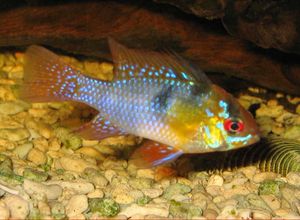Difference between revisions of "Breeding Mikrogeophagus ramirezi"
PsiPro bot (talk | contribs) m (clean up) |
(→External links: this link does not exist anymore) |
||
| Line 21: | Line 21: | ||
You can make your own liquid fry food. The BBS, egg yolk or dried whole egg, pea flour, yeast, [[spirulina]], and more can be mixed into the blender to form a liquid paste. The paste should be thick enough to pour like a milk shake at least. It can be taken in small amounts to place directly to the fish fry or to mix in a small container first to dispurse before adding. This can be kept in a refrigerator up to a week for use as needed. | You can make your own liquid fry food. The BBS, egg yolk or dried whole egg, pea flour, yeast, [[spirulina]], and more can be mixed into the blender to form a liquid paste. The paste should be thick enough to pour like a milk shake at least. It can be taken in small amounts to place directly to the fish fry or to mix in a small container first to dispurse before adding. This can be kept in a refrigerator up to a week for use as needed. | ||
| − | |||
| − | |||
| − | |||
[[Category:Fish Breeding]] | [[Category:Fish Breeding]] | ||
Latest revision as of 12:54, 14 February 2018
Breeding Mikrogeophagus ramirezi[edit]
Breeding German Blue Rams is usually easy once a pair bond is achieved. Often, Rams will not pair up just because a male and female are together. Getting multiple juveniles and letting them grow together often results in pair bonds. Once a pair bond is formed, a pH of 5.5 to 6.5 is the best for the adults, eggs, and fry. German Blue Rams become sexually mature fairly quickly - maturity can be reached as early as 4–6 months. Many aquarists report some pairs as being monogamous. Others have said German Blue Rams are polygamous and prefer the 'harem' approach.
Spawning[edit]
This is where breeding German Blue Rams can become a challenge, since breeding German Blue Rams is not always an easy task. Young German Blue Rams will most likely not get it right the first few times and some pairs spend most of their free time fighting: fluctuating lighting times may distort their breeding. A big red abdomen and a visible ovipositor is a good sign that a female is ready and willing, and the female or male cleaning a piece of rock, wood, or creating a pit in the sand of gravel is also a promising indication. The pair will begin to show a little more interest in one another by twirling and nudging each other, even at night. The male may display irregular bursts of energy where he'll dart away or begin sliding his body against the female. This bursting can be directed towards other Rams, especially competing males, females or pairs.
The female can lay between 20-200 eggs. Both parents will tend to the eggs. It is not unusual that the parents will eat the eggs, especially unfertilised ones. As mentioned previously, they may spawn several times until they get it right.
The Eggs[edit]
The eggs can fungus. The methylene blue can help, but not necessary if the tank water is clean. One website recommends the use of hydrogen peroxide in the low dose and repeated every 12 hours. The good water quality can help, but good water might mean old water that has a lower pH since there is evidence that the hatch rate is improved with the lower pH range. The survival or fry is probably improved with the lower pH.
Raising Fry[edit]
The feeding of the small fry can be tricky. Baby brine shrimp (BBS) should work, but there are certain fry in a batch that are too small to eat it. Some pairs produce smaller fry. It is recommended to mix other possible smaller foods together with the BBS.
There is the traditional food recommended infusoria, but this is "difficult" to produce and with the uncertain concentration.
Hard boiled egg yolk is another food old timers might use. One author holds the egg yolk in a cheese cloth and to squeeze in the water. I place the very small amount that is perhaps only half the size of a pea can be placed into a small container. A few drops of water is then added. The very small utensils can then be used to make a mash. Once it is smooth, then add more water. This should result in a fine emulsion and can be poured into the small container with the fry. The small bits float around and the fry can eat it easily. The remainder of the egg yolk can be kept in a food container and used for up to a week. (Less than 1/4 yolk is needed, so the balance can be eaten by the aquarist along with the egg white so as not to waste food.)
Another alternative is one of the brands of the liquid fry food. These are highly recommended, but might be only useful for a few days until fry can accept the BBS.
You can make your own liquid fry food. The BBS, egg yolk or dried whole egg, pea flour, yeast, spirulina, and more can be mixed into the blender to form a liquid paste. The paste should be thick enough to pour like a milk shake at least. It can be taken in small amounts to place directly to the fish fry or to mix in a small container first to dispurse before adding. This can be kept in a refrigerator up to a week for use as needed.
